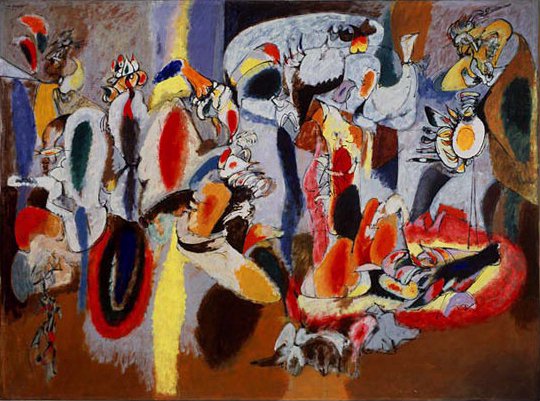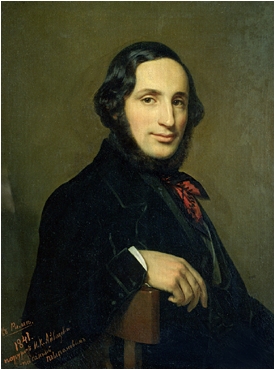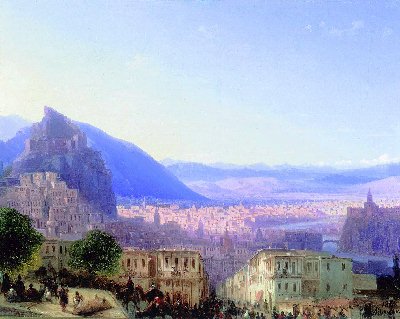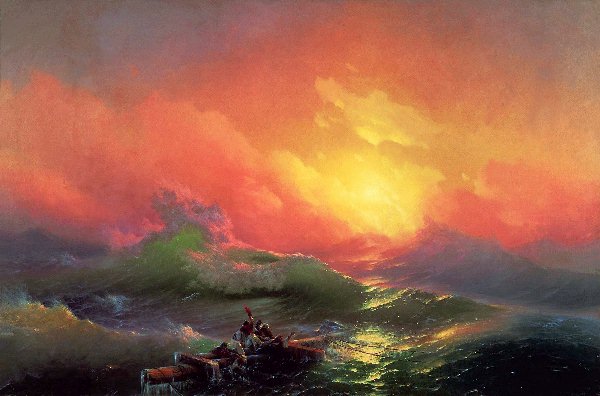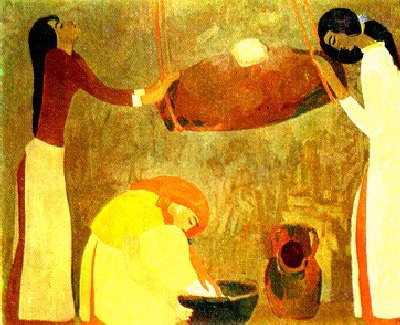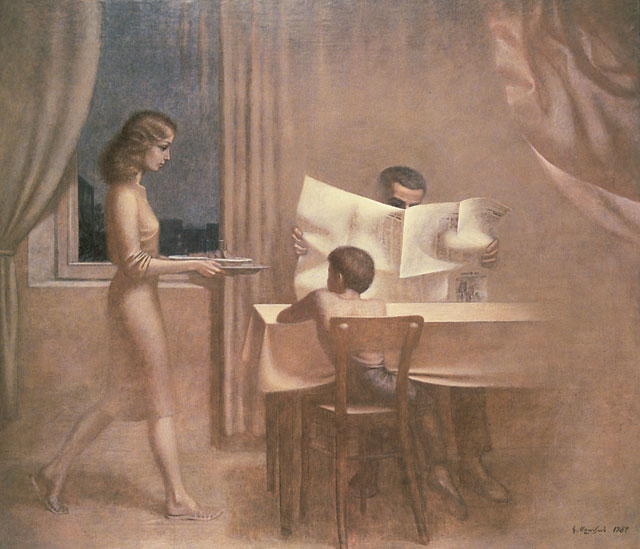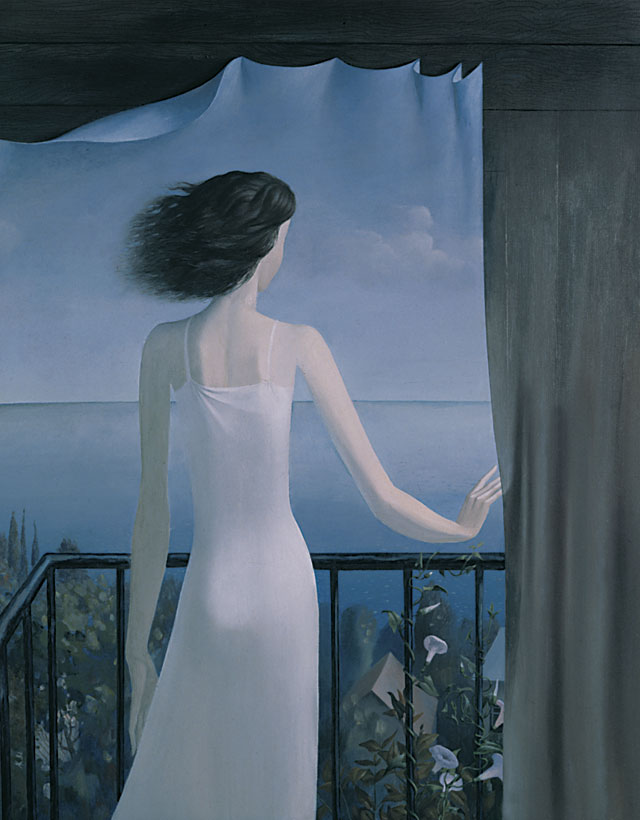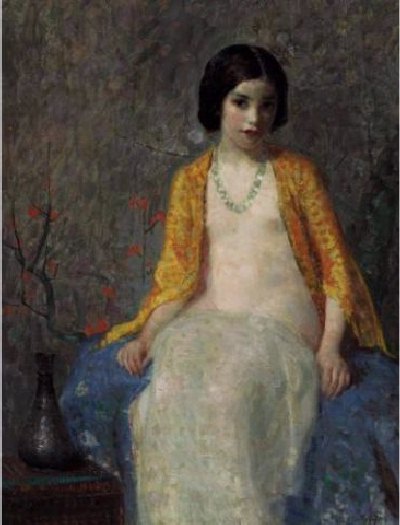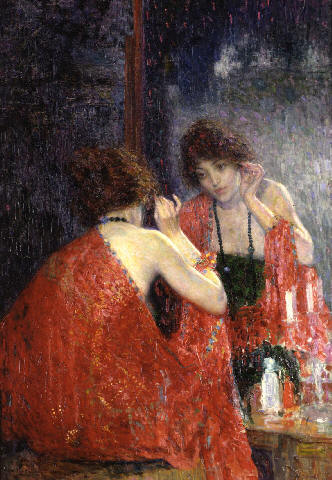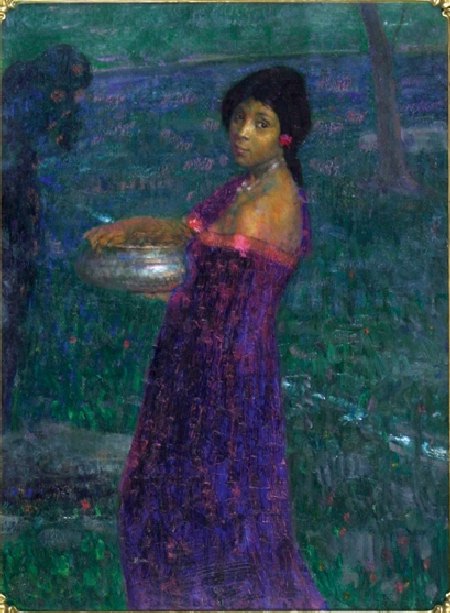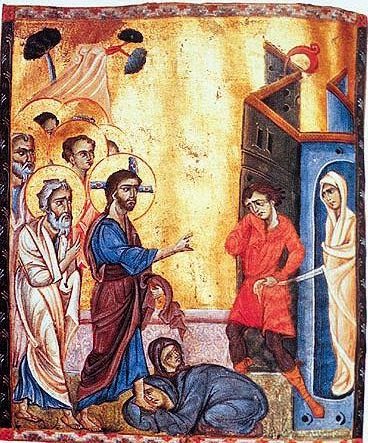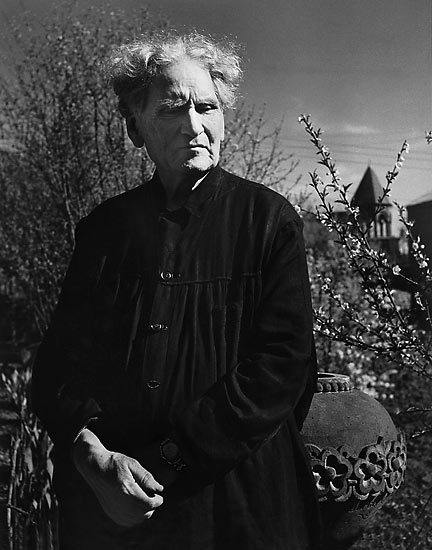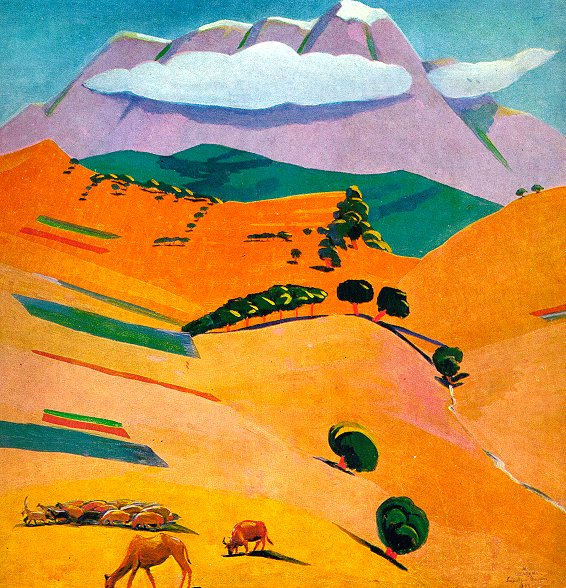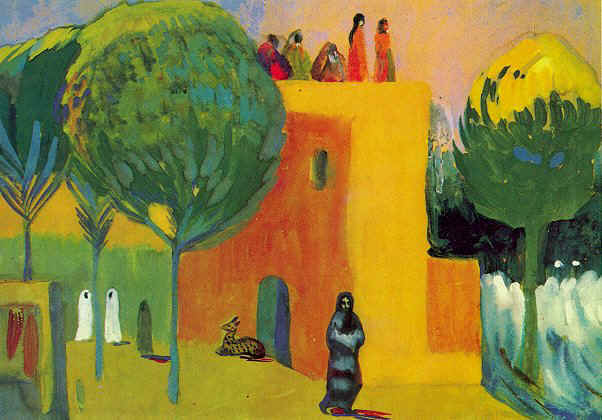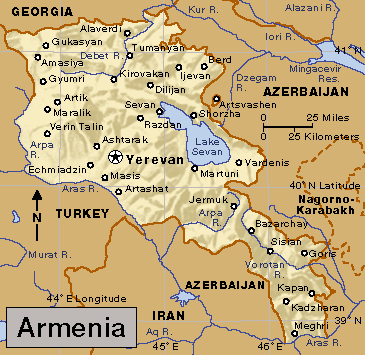| Armenian Artists
The Art History Archive - Soviet Art
Artists of Armenia
Arshile GorkyThe most famous Armenian artist is Arshile Gorky, born Vostanik Manoog Adoyan (April 15th 1904 - Died July 21st 1948) and widely considered to be the Father of Abstract Expressionism. Gorky was born in the Armenian village of Khorkom near Van. He moved to the United States in 1920 at the age of 16 and became extremely influential in the genesis of Abstract Expressionism. On July 21st 1948 Gorky hanged himself in Sherman, Connecticut at the age of 44. He was buried in North Cemetery in Sherman, Connecticut.
Ivan AivazovskyIvan Konstantinovich Aivazovsky (Born July 29, 1817 – Died May 5,1900), also known as Haivazovskiy, was a Russian painter of Armenian descent, most famous for his seascapes, which constitute more than half of his paintings. He gained international fame at the age of 25, was elected a member to five European Academies and was awarded the medal of the French Legion of Honor. Delacroix referred to him in reverence and Turner called him a genius. Aivazovskiy's name is intricately bound with the sea. In his best seascapes (and in a legacy of about 6000, there are some works which condescend to his artistic ability and others which merit singular artistic attention) he has revealed his inner self through the spirit of the times, his ideals of humanism, and the love of freedom. The artist lived by those ideals; the love that he had towards the oppressed, the help he offered and the work that he did for the public good make him an exceptional individual and a true son of his times. Aivazovskiy was born to a poor Armenian family in the city of Theodosia in the Crimea. Some of artist's paintings bear a signature, in Armenian letters, "Hovhannes Aivazian". At the age of twenty he graduates from the Art Academy of St. Petersburg with a gold medal. He goes to Italy to continue his studies and returns as an internationally acclaimed seascape painter. Neither financial security nor life in Palace interests him. He returns to his native land, builds a workplace on the seashore and, until the last days of his life, dedicates himself to the work that he loves. He participates in exhibitions all over the world. He gets recognition and glory as a representative of Russian art greatly helps in familiarizing it. In Aivazovskiy's creative work one finds such aspects of Armenian culture and national temperament that it becomes impossible to separate his art from his native people. It is this characteristic that gives Aivazovskiy's creativity its unique quality. Even in the early years, Aivazovskiy had a vivid and emotional understanding of reality. He always remained a romantic at heart even through his art could never separate itself from his academic background. The Artist's expressive language was in complete harmony with the techniques that he used. As a young boy Aivazovskiy had known the sea, had loved it passionately and had known the secrets of its movements. It was this memory, together with his imagination, that was responsible for his best works. Rather than merely "reproduce" the sea, Aivazovskiy tells us its fables and thus makes a symbolic statement. Aivazovskiy made his mark in contemporary art through his own rules and his own world view; he was true both to his academic background and his romantic inclinations. The concept of light is all important to Aivazovskiy. The perceptive viewer will observe that while painting the waves, clouds or sky space, the artist's emphasis is on the light. In Aivazovskiy's art light is the eternal symbol for life, hope and faith. This is light the creator, the concept of which has its roots deep down in Armenian culture and its continuity in the next generation of Armenian artists. To eliminate "The Armenian Question", Sultan Abdul Hamid, in 1895, ordered a series of massacres which claimed the life of hundreds of thousands of Armenians. Numerous Armenian cultural monuments were burned or destroyed. This tragic reality shocked the artist: "My heart is full of grief for our ill-fated people; for this tragic and unprecedented massacre", he wrote to the Armenian Catholicos Khrimian. He threw into the sea the medal that the Sultan had given him years before. He painted and exhibited canvases depicting the massacre. It was with pain and grief that he painted his last canvas "The Explosion of the Turkish Ship", which he could not finish. The date was May 2nd, 1900. Aivazovskiy's house in Theodosia became a place for artistic pilgrimage. Armenian artists were invited there and actors and musicians performed there. It was there that artists like Bashinjagyan, Sureniants, Makhokhian and Shabanian started their creative life. Aivazovskiy's dream was to create a union of Armenian artists from all over the world. During his long period of creative life, and especially after 1868, Aivazovskiy executed tens of canvases with Armenian themes. His landscapes depicting life in Tbilisi, Lake Sevan and Mount Ararat popularized the genre in Armenian art. He also had a series of works with themes from he bible and from ancient Armenian history. Two of his works, which were exhibited in the Church in Theodosia and have inspired patriotism ever since, are reproduced here for the first time. According to his wishes, Aivazovskiy was buried in the Armenian Church of St. Sarkis in Theodosia. His tombstone has a quotation from historian Khorenatsi's "History of Armenians" - "Born a mortal, he left immortal memories". The "memories" condense in them the spirit of the times and the most precious spirit of all time - that of Humanism. Ivan Konstantinovich Aivazovskiy was one of the most popular artists of his times. Artwork by Ivan Aivazovsky
Ivan Aivazovsky - The Coast Near St Petersburg - 1835
|
|
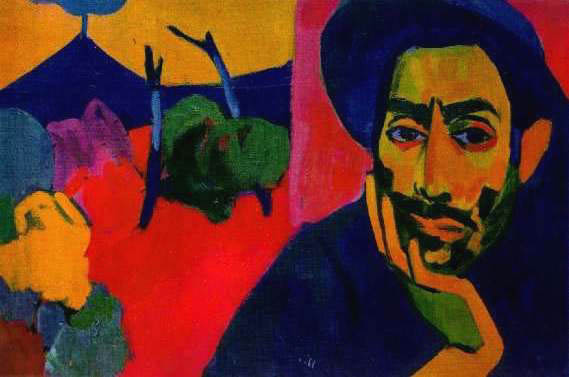
Minas AvetisyanMinas Avetisyan (Born July 20, 1928 — Died 1975) was a painter. He was born in the Armenian village of Djadjur. Leningrad, with its Academy of Fine Arts and its Hermitage, played a significant role in his becoming an artist. Avetisian always remembers with gratitude his teachers, Johannson, Zaitsev and Khudiakov: they never hindered the natural expression of his own artistic individuality. Both in his student years and after graduating from the Academy, Avetisian traveled widely around Armenia, eagerly seeking out historical monuments; he studied the Armenian miniature and the works of the greatest Armenian artists, above all, Saryan's. His real emergence as an artist was at the "Exhibition of Five" in Yerevan (1962), where he revealed himself as a mature painter with a bright individuality. Numerous specialists and visitors to the exhibition thought highly of his work. In the presence of a large group of visitors and representatives of the press, the French artist Jean Lurcat exclaimed: "This artist rivals France's best painters". He follows the national traditions in painting, yet he never resorts to slavish imitation or stylization. But he shows great freedom and originality in his use of means of expression found in the work of ancient miniaturists: bright sonorous colors, coordination of pictorial tension throughout the entire surface of the canvas, rhythmic arrangement of lines, the static quality of representation, and the absence of perspective. And this is quite natural: like any artist of great talent, Avetisian has achieved an understanding of reality not so much through the study of the work of other masters, as through his own perception and interpretation of life. Avetisian is one of those Armenian artists who put the color back into painting. "Put the color back into painting"-such an expression might seem strange, but if you go into the Matenadaran and look through the yellowed pages of the ancient manuscripts there, you will understand what is meant: there on the parchment, in all their splendor, shine the bright, sonorous colors- blue, yellow, green, red... Color plays an enormous role in the work of Avetisian. Some of his pictures are unequaled in contemporary Armenian painting in the intensity of their colors. A few of Avetisian's main canvases are devoted to the past of his people. It was by pure chance that the artist's parents escaped the 1915 massacre. Not far from Djadjur several thousands of people were killed in a ravine. The generation which saw these terrible events with their own eyes is still alive. Often on winter evenings, sitting by the hearth of his village home the artist heard the accounts of eye-witnesses. Perhaps this is why a dramatic note is perceptible in many of his works. Laconicism, reserve and thoughtfulness are characteristic for the artist too. The dramatic quality in Minas Avetisyan's history paintings is a tacit tribute to the memory of the dead. To the most significant canvases of this cycle belongs the picture "The Road: A Recollection of My Parents" (1965-1967). Unfortunately, like many of his other works, it perished in the 1972 fire. In the night of the January 1, 1972, while the artist was in Djadjur with his family, his Yerevan studio was burnt down together with a large portion of his best canvases selected for a one-man show.
After the profound shock inflicted on Avetisian by the burning down of his studio, which for a time brought his creative activity to a halt, the artist actively engaged in work and produced a series of significant canvases, among them "Meditation" (1972), displayed at the republic's exhibition, and "Baking Lavash" (1972) and other. Minas Avetisian belongs to those modern Armenian artists who prove, as did Martiros Saryan in his time, that one can be useful to one's people, expressing its hopes, in all sorts of ways, but with one absolute condition—in a language worthy of art.
Minas Avetisyan's Paintings
Minas Avetisyan - Djadjur - 1960
Karen AghamyanBorn in 1946, Karen Aghamyan is an Armenian-born painter and President of the Artist's Union of Armenia since 1998. Born in 1946 in Yerevan. In 1969, he graduated from the Yerevan Fine Arts and Theatre Institute and has been a member of the Artists' Union of the USSR since 1970. Since 1970 he has participated in more than 70 exhibitors, 11 of which were one-man shows. His pictures are property of museums of Armenia, Russia, Ukraine, France and private collections in many countries of the world. Aghamyan took a pencil at an early age like all other children, and by the age of four showed incredible talents which lead to him attending the Children's Art Studio when only five years old. He later graduated from the Yerevan College of Fine Arts and in 1970 started teaching at the Yerevan Fine Arts and Theatre Institute where he was made head of the Department of Design before taking up the position of Professor in 1994. In 1998 Aghamyan became President of the Artist's Union of Armenia. Aghamyan's works are not traditional - they are reserved, even hermetic. He searches, observes and mediates in different, quite unusual systems of expressiveness and the world becomes the object of his emphasized analytic attention. Aghamyan's compositions speak about symbolism and abstract romanticism, expressed under a new light of emotional experience of space. His paintings objects and people are painted gracefully and coolly.
Karen Aghamyan's Paintings
Karen Aghamyan - Entry into the Komsomol - 1981
Hovsep PushmanHovsep Pushman was one of those rare artists whose work was appreciated by both critics and collectors, and who enjoyed recognition and good fortune. In a 1932 one-man show at New York's Grand Central Art Galleries, the entire display of 16 Pushman paintings was sold before opening day's end. Pushman, later a naturalized American citizen, was born in Armenia in 1877. At age 11, he held a scholarship at the Constantinople Academy of Art. By 17, he had gone to the United States and started teaching art in Chicago. Pushman received his formal education in Paris at the Beaux-Arts Academie under Lefebvre, Robert-Fleury and Dechenaud. He exhibited his work at the Salon des Artistes Francais in Paris, winning a bronze medal in 1914 and a silver medal in 1921. He also was awarded the California Art Club's Ackerman prize in 1918. Pushman's artistic identity began to take shape after he opened his own studio in 1921. Robert-Fleury, upon seeing one of Pushman's early studio still lives, advised the artist, "That painting is you." Thereafter, Pushman's career was devoted to one subject, oriental mysticism, and one form, the still life. His paintings typically featured oriental idols, pottery and glassware, all glowing duskily as if illuminated by candlelight. They were symbolic, spiritual paintings, and were sometimes accompanied by readings, which help explain their allegorical significance. Most important, they were exquisitely beautiful, executed with technical precision. When "Twilight Comes" (date and location unknown) exemplifies the stunning beauty, mysterious mood and impeccable technique that made Pushman's work so highly respected. Hovsep Pushman, later a naturalized American citizen, was born in Armenia in 1877. At age 11, he held a scholarship at the Constantinople Academy of Art. By 17, he had gone to the United States and started teaching art in Chicago. He traveled for several years in China, immersing himself in oriental art and perhaps philosophy. He then studied in Paris under Lefebvre, Robert-Fleury and Dechenaud. He exhibited his work at the Salon des Artistes Francais in Paris, winning a bronze medal in 1914 and a silver medal in 1921. He also was awarded the California Art Club's Ackerman Prize in 1918. Pushman's artistic identity began to take shape after he opened his own studio in 1921. Robert Fleury, upon seeing one of Pushman's early studio still life's, advised the artist, "That painting is you." In a 1932 one-man show at New York's Grand Central Art Galleries, the entire display of 16 Pushman paintings was sold before opening day's end. Thereafter, Pushman's career was devoted to one subject, oriental mysticism, and one form, the still life. His paintings typically featured oriental idols, pottery and glassware, all glowing duskily as if illuminated by candlelight. They were symbolic, spiritual paintings, and were sometimes accompanied by readings, which help explain their allegorical significance. Most important, they were exquisitely beautiful, executed with technical precision. "When Twilight Comes" (date and location unknown) exemplifies the stunning beauty, mysterious mood and impeccable technique that made Pushman's work so highly respected. Pushman died in 1966 in New York City.
Hovsep Pushman's Paintings
Hovsep Pushman - Youth - 1924
Toros RoslinToros Roslin (c. 1210 – 1270 or c. 1216 – 1288) was the most prominent master of the Armenian illuminated manuscript in the Middle Ages. Biographies of Medieval and ancient Armenian artists had a tendency to ignore aspects we today would consider important. This and other issues means that little of his life is currently known for certain. It can be said that he worked in the Armenian Kingdom of Cilicia, because of his patrons. Also that he had children as an adult son is mentioned. This is seen as indicating he was likely a priest as a monk would have no children while a member of the laity would likely not have done Illuminated Bibles as he did. His works show some Byzantine and even Italian influences so some believe he travelled to foreign lands in his twenties. He did a portrait of Leo III of Armenia when that man was a prince sometime around 1256. He also did work for Prince Vasak; although he is best known for religious works, particularly concerning New Testament themes like the Crucifixion of Christ or The Nativity of Jesus.
Toros Roslin's Illuminations
Toros Roslin - Portrait of Prince Levon - 1250
Martiros SaryanMartiros Saryan (Born either 16 or 28 February 1880 — Died 5 May 1972) was a Soviet-Armenian painter. Saryan was one of the plead of major cultural figures of Armenia at the turn of the century. His work, in common with the library contributions of O. Tumanian and A. Isaakian, those of T. Toramanian and A. Tamanian in architecture, and of Komitas in national music, set the standard of national art, and laid the foundations for its flowering in the Soviet period. Hi was born in 1880 and dead in 1972. In the course of his long life, Saryan experienced much sorrow and much joy. He witnessed the two World Wars and the tragedy of genocide in Armenia in 1915. He suffered the destruction of many of his paintings, and the death of his beloved son. Recalling his own background, Saryan said, "My ancestors had come to the banks of the river Don from the Crimea, and to the Crimea from Ani, the capital of medieval Armenia. I was born into a family which followed the old patriarchal customs. There were nine children and I was the seventh." I do not know when the artist was born in me. It was probably in those days when I used to listen to my parents' stories about our mountainous, enchanted country, when I used to run as a small boy over the land around our home, and was filled with joy at the many colors of the butterflies, insects and flowers. Color, light and day-dreaming - those are what fired me". The Fancies and Dreams present a synthesis of the aesthetic aims which the artist set himself at that time. He was striving to represent nature symbolically as a "living entity". The works of this period, which Saryan began to show at Moscow exhibitions, were executed mainly in watercolors and tempera. They include: "Flowering Mountains", "The Comet"," By the sea: Sphinx", "Two Panthers", "Under the Pomegranate", "At the Well on a Hot Day" and others. A new stage in Saryan's work began in 1909. There is no longer anything fantastic in the subjects of such paintings as "Self-portrait" (two versions), "In the Grove at Sambek", "Morning at Stavrino", "Hyenas", or "Burning Heat with a Dog Running". In "Morning at Stavrino", an actual place is depicted, the yard of his father's farm, yet the canvas breathes the mystery of awakening nature. Among his celebrated pictures belonging to the beginning of the 1910s are "A Street at Noon: Constantinople, Dogs of Constantinople, Date-palm in Egypt, Night Landscape, Still-life with Grapes, Flowers of Kalaki, Still-life with Masks, Flowers of the East". Each of these works, with its brilliant, joyous colors, overcomes the viewer with a sensation of the joy of life. Landscape always remained a leading aspect of Saryan's art. But beginning with the 1920s landscape became more synthetic monumental in character. The artist creates a generalized image of Armenia. In the paintings "Armenia", "Mountains", "Midday Stillness", "Erevan", "Mount Aragats", an effect of spatial depth is achieved through a balanced arrangement of saturated color patches. The absolute harmony of color and light arouses in the viewer a restful feeling, a deep sense of peace. The artist brings to each of his works the most delicate shades of a mood, an intimate, lyrical mood in most cases. He composes cycles in which the meaning of the present and the eternal is philosophically explored. One such series consisting of seven landscapes, "My Homeland". Saryan's work is not limited to his paintings in oil and -later -tempera: he also drew a great deal and painted in watercolors. His sketches from life are outstanding. Saryan was famous for his work in the field of book illustration. Particularly in the 1930s, he worked enthusiastically in graphics and did his wonderful illustrations to the works of Tumanian, Isaakian, Charents, and to the poem of Firdawsi, "Shah-Nameh", Saryan also worked in monumental painting and in the sphere of theatrical design. To the end of his life he never lost his talent for work or the freshness of his vision. The vitality of Saryan's genuinely national art lies in its truth to the character of the artist's homeland, in its originality and its purely coloristic beauty. The master always managed to achieve a striking clarity and simplicity in the expression of complex ideas. His works are in no sense rationalistic; they are deeply emotional. He was born into an Armenian family in Nor Nakhijevan (now part of Rostov-on-Don, Russia). In 1895, aged 15, he completed the Nakhichevan school and from 1897 to 1904 studied at the Moscow School of Arts, including in the workshops of Valentin Serov and Konstantin Korovin. He was heavily influenced by the work of Paul Gauguin and Henri Matisse. He exhibited his works in various shows. He had works shown at the Blue Rose (art group) Exhibit in Moscow. He first visited Armenia, then part of the Russian Empire, in 1901, visiting Lori, Shirak, Echmiadzin, Haghpat, Sanahin, Yerevan and Sevan. From 1910 to 1913 he traveled extensively in Turkey, Egypt and Iran. In 1915 he went to Echmiadzin to help refugees who had fled from the Armenian genocide in the Ottoman Empire. In 1916 he traveled to Tiflis (now Tbilisi) where he married Lusik Agayan. It was there that he helped organise the Society of Armenian Artists. After the Bolshevik seizure of power in 1917 he went with his family to live in Russia. In 1921 they moved to Armenia. While most of his work reflected the Armenian landscape, he also designed the coat of arms for Armenian SSR and designed the curtain for the first Armenian state theatre. From 1926 - 1928 he lived and worked in Paris, but most works from this period were destroyed in a fire on board the boat on which he returned to the Soviet Union. In the difficult years of the 1930s, he mainly devoted himself again to landscape painting, as well as portraits. He also was chosen as a deputy to the USSR Supreme Soviet and was awarded the Order of Lenin three times and other awards and medals. Saryan died in Yerevan on 5 May 1972. His former home in Yerevan is now a museum dedicated to his work with hundreds of items on display. He was buried in Yerevan at the Pantheon next to Komitas Vardapet.
Martiros Saryan Quotes"Nature's ways are wonderful and unfathomable. The grain swells in the soil, the sprout grows and flowers when the time comes and then it bears new fruit and so does not die. We are like grain. We never die because we are One with Nature. To understand this is to comprehend Immortality--the Apotheosis of the Human Race. It is with this conviction that I have lived my Life. My Life is a store of my experience, a Life of aspirations, sorrows, joys and triumphs." - Martiros Saryan. "Life is an island. People come out of the sea, cross the island, and return to the sea. But this short life is long and beautiful. In getting to know nature man exalts the wonder and beauty of life." - Martiros Saryan.
Martiros Saryan's Paintings
Martiros Saryan - The Spell of the Sun - 1905
Lesser Known Armenian ArtistsStepan Aghajanian (Born December 16, 1863, Shushi - Died December 13, 1940, Yerevan) was an Armenian painter, People's Artist of Armenia (1938). He is one of the main figures in Armenian fine arts of the 20th century, practiced various genres and was particularly distinguished as a portrait artist. Aghajanian studied in Shushi, then in Baku, Marcel and Paris Academy of Fine Arts. Since 1922 he worked in Armenia. Hakob Hakobian (Hakobyan) (Born 1923, Egypt) is a modern Armenian painter. He has awarded by the honorary title of People's Artist of the Armenian SSR and a State Prize of the Armenia titles. He studied at the Melkonian Armenian school (Cyprus) and Acade'mie de la Grande Chaumiere. His early works are small-size oils: one-figure compositions in interiors and still lifes. Hakobyan moved to his historical homeland, Armenia, from Egypt in 1962, and his new world became the native landscape. His personages are social or occupational types, static figures circumscribed by a space limited in depth, their mood of constraint and isolation suggest a miserable existence. Hakobian made several exhibitions in Yerevan, Moscow and other cities. Mariam Arshaki Aslamazian (Born 1907, Bash-Shirak village, near Leninakan - Died 2006, Moscow) was a Soviet painter, People's Artist of Armenian SSR (1965). She was the sister of painter Yeranuhi Aslamazian. They presented a big number of their works to their native town's Gyumri Aslamazian Sisters Museum. She was the student of Stepan Aghajanian and Petrov-Vodkin. Her paintings evoke the dramatic, colorful themes of the period of her life. While critics argue the relative strengths of her paintings, her exquisite ceramic plates are universally proclaimed masterpieces. Mariam Aslamazian died in Moscow, and was burried in Yerevan's Pantheon. Mikael Aveti Arutchian (Born July 6, 1897, Shushi - Died June 9, 1961, Moscow) was a Soviet Armenian theatral painter and designer, People's artist of Armenia (1958). He is one of the founders of Armenian theatral-decorative art. He also worked as book illustrator and wallpaper designer. He graduated in Saratov (1920-23) and Paris (1924-25). He designed more than 100 theatral productions including "Revolt" (1928), "In circle" (1930), "Figaro's marriage" (1933), "Othello" (1940) - at Sundukyan theatre of Yerevan (he was the chief painter from 1928 to 1939); "Pikovaya dama" (1956) - at Yerevan theatre of opera and ballet (he was the chief designer in 1939-49). Panos Poghosi Terlemezian (Born March 3, 1865, Van - Died April 30, 1941, Yerevan) was an Armenian painter, awarded by the People's Artist of Armenian SSR title in 1935. One of the leaders of Van Resistance, 1915. Terlemezian was born in Van, Western Armenia, Ottoman Empire. He finished an art society school in Saint-Petersburg, then studied at the Julianne Academie of Paris (1899-1904). After the Armenian Genocide he moved to Yerevan. Influenced by impressionism, he became the author of industrial pictures (1929-31, National Gallery of Armenia). Sarkis Ordyan (Born December 20, 1918 - Died 2003) was a Ukrainian-Armenian painter. Sarkis died in 2003, and is buried in Odessa, Ukraine. Ordyan was born to unknown parents in the village of Aigedzor, in the Tavush region of Armenia (then a disputed territory between the Democratic Republic of Armenia and the Azerbaijan Democratic Republic). He was married to Arevhat Grigoryan and had two children, Rafik Ordyan and Anahit Ordyan. Ordyan left Armenia for Moldova where he lived for several years until settling in Ukraine. In the city of Odessa, he became known as "The Lonely Painter".
| |
